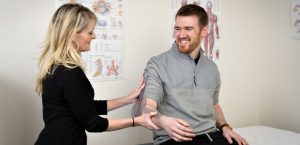Learn more about the primary approaches driving today’s telerehabilitation services and how they can serve the workers’ compensation market.
 In recent years, we have seen a growing body of research supporting the positive impact telemedicine can bring to patient care. As a result, telehealth has picked up steam among group health payers, with a growing number of patients interested in trying a remote care option in lieu of an in-person visit. However, telemedicine is only just now generating interest in the workers’ compensation arena. The obvious benefits for injury triage, case management and physician follow-up is clear – but the value of telemedicine for a traditionally hands-on service like physical therapy has not yet been recognized fully. Below we explore three models of telemedicine technology, how they’re being used in PT and the benefits of each.
In recent years, we have seen a growing body of research supporting the positive impact telemedicine can bring to patient care. As a result, telehealth has picked up steam among group health payers, with a growing number of patients interested in trying a remote care option in lieu of an in-person visit. However, telemedicine is only just now generating interest in the workers’ compensation arena. The obvious benefits for injury triage, case management and physician follow-up is clear – but the value of telemedicine for a traditionally hands-on service like physical therapy has not yet been recognized fully. Below we explore three models of telemedicine technology, how they’re being used in PT and the benefits of each.
Live Video (Synchronous)
Often referred to as “real-time,” synchronous telehealth tools facilitate live, two-way interactions between patients, caregivers and providers using audiovisual technologies. This type of telemedical care is often employed as an alternative to an on-site clinical visit for the purposes of consultation and diagnosis. In addition to reducing transportation costs and bolstering access to care in remote areas or during off hours, these convenient virtual visits have been shown to improve patient satisfaction and potentially improve care outcomes. This type of technology may be used by physical therapists to perform an at-work environmental assessment, conduct a goal setting session or dispense patient education. It may also be possible to administer functional training, movement facilitation, a guided assessment or a therapeutic exercise through the use of live video.
Store-and-Forward (Asynchronous)
As the name indicates, store-and-forward telemedicine involves the secure transmission of pre-recorded materials. A wave of tech start-ups and apps has been developed to generate educational tools for patients. Orca Health, an educational app company, provides tools that PTs can use to explain common injuries of the shoulder, knee and spine in layman’s terms through the use of interactive anatomical 3-D models, videos and images. Orca’s videos demonstrating stretches and strengthening techniques are also a valuable resource for patients to safely and accurately execute therapeutic exercises away from the clinic.
But store-and-forward applications don’t just benefit patients; they also strengthen communication between providers by facilitating the transmission of documented patient history including videos, digital images, lab results and health records. Asynchronous platforms designed for this purpose provide the means to exchange protected health information in a secure manner. This technology is often employed when a physical therapist needs to evaluate a case or render a service outside of a live interaction. Clinical store-and-forward applications have become quite common, enabling faster diagnoses and better treatment strategies, especially in settings where specialists may not be readily available. Inexpensive and easy to use, asynchronous telemedicine services can also lower wait times by optimizing the use of health care providers’ time.
Remote Patient Monitoring (RPM)
RPM technologies allow an individual’s personal health and medical data to be collected and transmitted to a provider. Often used to aid chronic disease management – such as diabetes, heart conditions or high blood pressure – these platforms allow providers to track a patient’s vital signs while they are at home or in a care facility. In many cases, the RPM data is transmitted automatically, generating a report for the provider or a team of health monitoring professionals who flag unusual findings for clinical review. By providing practitioners the means to monitor for early warning signs and quickly intervene, RPM, or telemonitoring, can help patients adhere to their treatment plan and potentially reduce life-threatening complications.
The latest RPM technology for telerehabilitation includes The Vera System, a new innovation from Reflexion Health, which guides patients through exercises and, using cutting-edge motion-tracking technology, tracks their movements to ensure they are doing them correctly. The physical therapist receives the performance data, and the patient receives real-time feedback and tips as they perform the exercises. Duke University plans to research the effectiveness of the system in its in-progress 2017 study.
A Look to the Future
Although different in their approaches, all three models of telemedicine can deliver significant value for physical rehabilitation. It is only a matter of time before telerehabilitation becomes integrated into treatment strategies for patient-centered organizations. In a world where people use apps to track everything from fitness and eating habits to nightly sleeping patterns, it is easy to imagine a healthcare system where the link between technology and physical medicine is strengthened: where, through the latest technologies, patients can reach their healthcare provider quickly and easily, and where injured workers are guaranteed the therapeutic support they need when and where they need it most.



